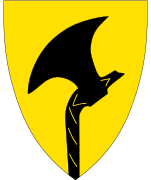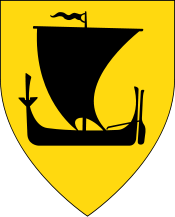Telemark
| Telemark fylke | ||
|---|---|---|
| County | ||
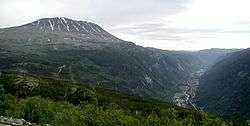 | ||
| ||
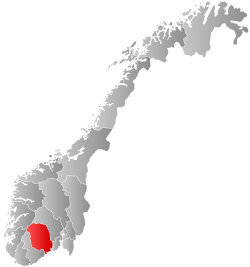 Telemark within Norway | ||
| Country | Norway | |
| County | Telemark | |
| Region | Østlandet | |
| County ID | NO-08 | |
| Administrative centre | Skien | |
| Government | ||
| • Governor |
Sven Tore Løkslid Arbeiderpartiet (2015–present) | |
| • County mayor |
Gunn Marit Helgesen Høyre (2003–present) | |
| Area | ||
| • Total | 15,299 km2 (5,907 sq mi) | |
| • Land | 13,854 km2 (5,349 sq mi) | |
| Area rank | #10 in Norway, 4.55% of Norway's land area | |
| Population (2014) | ||
| • Total | 171,333 | |
| • Rank | 13 (3.63% of country) | |
| • Density | 12/km2 (30/sq mi) | |
| • Change (10 years) | 1.8 % | |
| Demonym(s) | Teledøl or Telemarketer | |
| Time zone | UTC+01 (CET) | |
| • Summer (DST) | UTC+02 (CEST) | |
| Official language form | Neutral | |
| Income (per capita) | 139,900 NOK | |
| GDP (per capita) | 219,404 NOK (2001) | |
| GDP national rank | 12 (2.38% of country) | |
| Website |
www | |
|
| ||
Telemark [²teːləmɑrk] (![]()
Upper Telemark or Telemark proper has a varied and often scenic landscape, with many hills, mountains, valleys and lakes. It traditionally lacked cities and is marked by its distinct cultural traditions in regards to language, music, clothing, handcrafts, food, architecture and its traditionally egalitarian farmer society dating back to the Viking Age. It retained Norse culture and linguistic heritage to a larger degree than other regions in Norway, and was historically regarded as the most violent society in Norway. The region resisted both Christianization and later the Reformation longer than other Norwegian regions. It has more buildings from medieval times than any other Norwegian region, and is known as the birthplace of skiing and the Bunad movement.
Grenland, the flatter coastal areas of the modern county, is traditionally characterized by its wealthy cities and its involvement in seafaring and trade with the Low Countries, northern Germany and the British isles, with a more urban and continental culture, also influenced by its closer contact with Denmark. It was also Norway's most important industrial region since the 16th century, with its ironworks and sawmills.
Telemark county will merge with neighboring Vestfold County on January 1, 2020 as part of a nationwide regional reform, to become part of the combined Telemark and Vestfold county.[1][2]
History
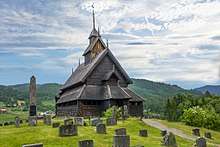
.jpg)
.jpg)
The modern county of Telemark consists of several distinct historical regions. It takes its name from the largest of them, which is now called Upper Telemark, but which was historically simply called Telemark. Telemark is named for the thelir (Þilir in Old Norse), the ancient Germanic tribe that inhabited what is now known as Upper Telemark since the Migration Period and during the Viking Age. The Norse form of the name was Þelamǫrk. The first element is the genitive plural case of þelir while the last element is mǫrk "woodland, borderland, march".
Traditional Telemark, i.e. Upper Telemark, is located in the inland of the modern county, and comprises more than two thirds of it according to its traditional definition. Both in medieval times and later (Upper) Telemark was the region of Norway with the most self-owning farmers.[3] It retained Norse culture to a larger degree than any other region in Norway, with respect to its more egalitarian organisation of society, religion, traditional values and language. Thus the people of Telemark were often described during the middle ages and early modern era as the most violent in Norway.[4] The dialects of Upper Telemark are also the dialects of Norwegian that are closest to Old Norse. The farmers of Telemark were marked by a strong-willed conservatism and belief in their traditional values that often defied the central authorities of Denmark-Norway; for example they held on to aspects of both Old Norse religion and later of Catholicism longer than other regions in Norway. (Upper) Telemark traditionally lacks cities entirely.
Grenland and the Skien fjord are flatter regions located closer to or at the coast. Historically Grenland referred to what is now called Midt-Telemark, but over time the name Grenland has come to refer to the Skien fjord area. The latter is traditionally characterized by its cities and its involvement in seafaring and trade. It also includes several larger agricultural properties and estates, as well as industry. The culture and social structure are more urban, far less traditional, more influenced by contact with continental Europe and far less egalitarian. The most important city of the region, Skien, was historically one of Norway's most important cities, although its importance declined after the Napoleonic Wars. The playwright Henrik Ibsen was a native of Skien, and many of his plays are set in places reminiscent of the city and area.
During the Dano-Norwegian union the traditional regions of Telemark and Grenland/the Skien fjord became the fief (len) and later county (amt) of Bratsberg (Bradsberg). The fief and county was named after the farm Bratsberg (Norse Brattsberg), since this was the seat of the governor. The first element is the genitive case of brattr m "steep mountain", the last element is berg n "mountain". (The name is referring to a steep mountainside behind the farm.) In 1919 Bratsberg county was renamed Telemark. Despite this, Grenland retains a separate identity that is distinct from Telemark proper; the minority in the Storting voted for the name Grenland–Telemark in 1918.
(Upper) Telemark, particularly Kviteseid, is known as the birthplace of skiing as a modern sport. Telemark lent its name to Telemark skiing, a style invented by Sondre Norheim, and the characteristic Telemark landing of ski jumping. Telemark is also known as the centre of the Bunad movement. Telemark has more buildings from medieval times than any other Norwegian region.
Geography
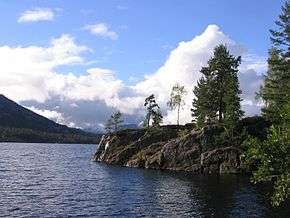
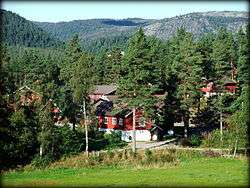
The county is located in southeastern Norway, extending from Hardangervidda to the Skagerrak coast. The coastline extends from Langesundsfjorden to Gjernestangen at the border with Aust-Agder. Telemark has a very broken and heterogeneous landscape, including many hills and valleys.
Infrastructure
The international road E18 goes through the southern parts of Telemark, namely Grenland and the municipality of Kragerø. E134, another important motorway and the fastest route between Oslo and Bergen, goes through the municipalities of Vinje, Tokke, Kviteseid, Seljord, Hjartdal and Notodden. RV36, stretching from Porsgrunn to Seljord, links the E18 and E134 motorways.
Telemark is well served by railways. The Sørlandet Line runs through the traditional districts of Vestmar and Midt-Telemark, serving the municipalities of Drangedal, Nome, Bø and Sauherad. Grenland is primarily served by the Vestfold Line, but also has connections through the Bratsberg Line which runs between Skien and Notodden.
From Langesund, Fjordline operates ferry services to Sweden and Denmark.
The main bus lines in the county are operated by Telemark Bilruter, serving western and middle parts of the county, and Nettbuss which serves the middle, eastern and southern parts of the county. Drangedal Bilruter serves the Vestmar region.
Population
| Historical population | ||
|---|---|---|
| Year | Pop. | ±% |
| 1951 | 136,519 | — |
| 1961 | 149,943 | +9.8% |
| 1971 | 156,778 | +4.6% |
| 1981 | 162,050 | +3.4% |
| 1991 | 162,869 | +0.5% |
| 2001 | 165,595 | +1.7% |
| 2011 | 169,185 | +2.2% |
| 2021? | 180,966 | +7.0% |
| 2031? | 191,552 | +5.8% |
| Source: Statistics Norway.[6] | ||
The largest population centres are Skien, Porsgrunn, Notodden, Rjukan and Kragerø. Other important places are Bø, Seljord, Fyresdal and Vinje.
Coat-of-arms
The coat-of-arms is from modern times (1970). It shows an old type of battle axe, significant for the county.
Notable people from Telemark
- Myllarguten (1801–1872), legendary fiddler born in Sauherad
- Aasmund Olavsson Vinje (1818–1870), author born in Vinje
- Sondre Norheim (1825–1897), father of skiing born in Morgedal, Kviteseid
- August Cappelen (1827–1852), national romantic painter born in Skien
- Snowshoe Thompson (Jon Torsteinson-Rue) (1827–1876),[9] American pioneer[10] and father of California skiing
- Henrik Ibsen (1828–1906), author born in Skien
- John Anders Johnson (1832–1901), American politician
- Thorbjorn N. Mohn (1844–1899), American Lutheran church leader and first president of St. Olaf College
- Brynild Anundsen (1844–1913), founder of Decorah Posten
- Marcus Olaus Bøckmann (1849–1942), Norwegian-American Lutheran theologian
- Herbjørn Gausta (1854–1924), American artist. Born in Vestfjørddalen
- Theodor Kittelsen (1857–1914), artist born in Kragerø
- Vidkun Quisling (1887–1945), politician, collaborationist leader during World War II. Executed as a traitor, born in Fyresdal
- Aslaug Vaa (1889–1965), author born in Rauland
- Tarjei Vesaas (1897–1970), author born in Vinje
- Anne Grimdalen (1899–1961), sculptor born in Skafså, Tokke
- Eivind Groven (1901–1977), composer born in Lårdal, Tokke
- Dyre Vaa (1903–1980), sculptor born in Vinje
- Klaus Egge (1906–1979), composer born in Gransherad, Notodden
- Gunnar Sønsteby, (1918–2012), war hero born in Rjukan, Tinn
- Hans Herbjørnsrud (1938–), author born in Heddal, Notodden
- Tor Åge Bringsværd (1939–), author born in Skien
- Agnes Buen Garnås (1946–), musician born in Jondal
- Kåre Nordstoga (1954–), musician born in Notodden
- Bugge Wesseltoft (1964-), musician born in Porsgrunn
- Gisle Kverndokk (1967–), composer born in Skien
- Jørn Lande (1968–), hard rock/heavy metal singer born in Rjukan
- Odd Nordstoga (1972–), musician born in Vinje
- Frode Johnsen (1974–), footballer born in Skien
- Terje Haakonsen (1974–), snowboarder born in Vinje
- Ihsahn (Vegard Sverre Tveitan) (1975–), black/extreme metal musician born in Notodden.
Districts
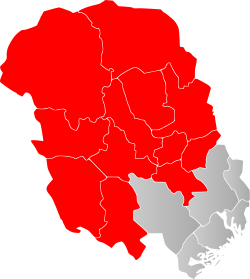
The county is conventionally divided into traditional districts. Traditionally the county is mainly divided into Upper Telemark (historically called simply Telemark or more recently Telemark proper) and Grenland. Upper Telemark is sometimes subdivided into Vest-Telemark and Aust-Telemark. The name Lower Telemark traditionally refers to Grenland and Midt-Telemark, but was more of an administrative region than a cultural one. Regardless of definition, Upper Telemark constitutes the largest part by far. For example the modern provostship of Upper Telemark comprises 12 municipalities and more than 80% of Telemark, also including Midt-Telemark.
An additional district, Vestmar is disputed. The district borders of this county are highly overlapping and to a certain extent undefined and/or disputed.
| Rank | Name | Inhabitants[11] | Area km2 | District |
|---|---|---|---|---|
| 1 | 63,962 | 722 | Grenland | |
| 2 | 35,177 | 161 | Grenland | |
| 3 | 14,107 | 282 | Grenland | |
| 4 | 12,390 | 856 | Aust-Telemark | |
| 5 | 10,620 | 289 | Grenland | |
| 6 | 6,527 | 389 | Aust-Telemark | |
| 7 | 6,022 | 1,858 | Vest-Telemark | |
| 8 | 5,595 | 260 | Aust-Telemark | |
| 9 | 4,666 | 292 | Aust-Telemark | |
| 10 | 4,159 | 998 | Grenland | |
| 11 | 3,641 | 2,740 | Vest-Telemark | |
| 12 | 2,966 | 672 | Vest-Telemark | |
| 13 | 2,522 | 626 | Vest-Telemark | |
| 14 | 2,412 | 203 | Grenland | |
| 15 | 2,337 | 907 | Vest-Telemark | |
| 16 | 1,587 | 741 | Aust-Telemark | |
| 17 | 1,404 | 789 | Vest-Telemark | |
| 18 | 1,381 | 1,110 | Vest-Telemark | |
| Total | 168,231 | 13,173 |
References
- ↑ Selland, Svein-Gunnar; Lundbo, Sten (8 June 2018). "Telemark" – via Store norske leksikon.
- ↑ "Nå er Telemark og Vestfold slått sammen". ta.no. 8 June 2017.
- ↑ Hans Jacob Orning, "Et lokalt maktspill", Norgeshistorie.no, 28 November 2016
- ↑ Hans Jacob Orning, "De voldelige telemarksbøndene", Norgeshistorie.no, 28 November 2016
- ↑ Nilsen, Jan Erik; Lundbo, Sten (5 March 2018). "Nissedal" – via Store norske leksikon.
- ↑ "Statistikkbanken". ssb.no. 26 May 2012. Archived from the original on 26 May 2012.
- ↑ Statistics Norway - Church of Norway. Archived 2012-07-16 at Archive.is
- ↑ "Statistics Norway - Members of religious and life stance communities outside the Church of Norway, by religion/life stance. County. 2006-2010". ssb.no.
- ↑ "History – Snowshoe Thompson". snowshoethompson.org.
- ↑ https://postalmuseum.si.edu/exhibits/current/networking-a-nation/john-snowshoe-thompson.html
- ↑ "Statistics Norway". 1 January 2010.
External links
| Wikimedia Commons has media related to Telemark. |
| Wikivoyage has a travel guide for Telemark. |
